60 7. Exercises (Part 2)
-
Last updated
- Dec 28, 2020
Exercises: Set B
- Make-or-Buy Decision. Quality Glass currently manufactures windshields for automobiles. Management is interested in outsourcing production of these windshields to a reputable manufacturing company that can supply the windshields for $45 per unit. Quality Glass incurs the following annual production costs to produce 15,000 windshields internally.

If production is outsourced, all variable production costs will be eliminated, and 80 percent of fixed production costs will be eliminated. Regardless of the decision to outsource or to produce internally, 20 percent of fixed production costs will remain .
Required:
- Perform differential analysis using the format presented in Figure 7.2. Assume making windshields internally is Alternative 1, and buying windshields from an outside manufacturer is Alternative 2.
- Which alternative is best? Explain.
- Summarize the result of outsourcing production using the format presented in Figure 7.3.
- Why might some managers prefer the format presented in requirement c?
-
Product Line Decision. The following segmented annual income statement is for Office Express.
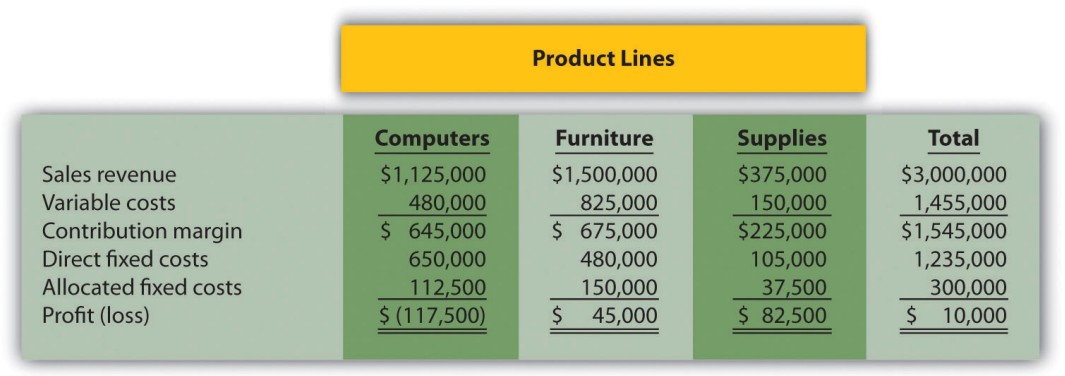
Management is concerned about the significant losses associated with the computers product line and would like to drop this product line. Allocated fixed costs are assigned to product lines based on sales. If the computers product line is eliminated, total allocated fixed costs are assigned to the remaining product lines, and all variable and direct fixed cost for the computers product line will be eliminated.
Required:
- Perform differential analysis using the format presented in Figure 9.6. Assume keeping all product lines is Alternative 1, and dropping the computers product line is Alternative 2.
- Which alternative is best? Explain.
- Summarize the result of dropping the computer product line using the format presented in Figure 9.7.
- Explain what happened to the profitability of the furniture product line as a result of dropping the computers product line.
- Customer Decision. The following customer segmented annual income statement is for Management Consulting, Inc.
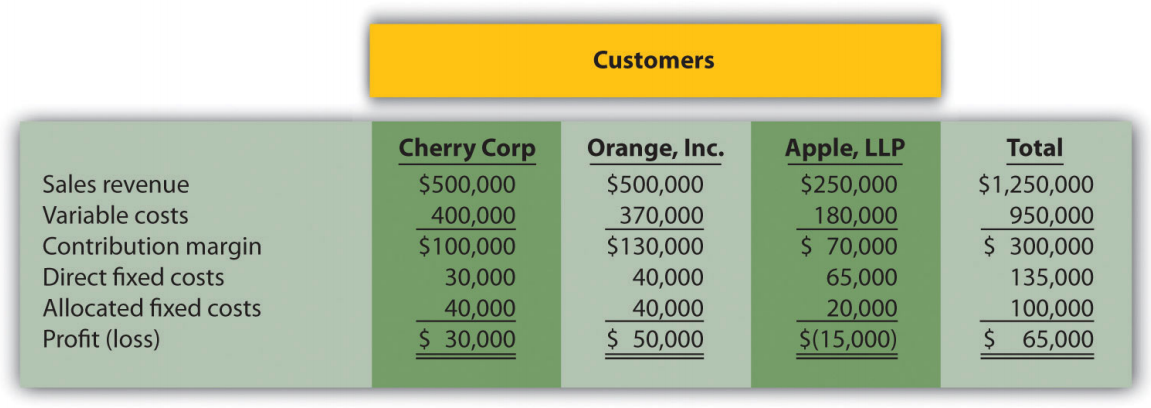
Management is concerned about the losses associated with the Apple LLP account and would like to drop this customer. Allocated fixed costs are assigned to customers based on sales revenue. If Apple LLP is dropped, total allocated fixed costs are assigned to the remaining customers, and all variable and direct fixed costs for the Apple LLP account will be eliminated.
Required:
- Perform differential analysis using the format presented in Figure 9.10. Assume keeping all customers is Alternative 1, and dropping the Apple LLP account is Alternative 2.
- Which alternative is best? Explain.
- Summarize the result of dropping the Apple LLP account using the format presented in Figure 9.12.
- Explain why the loss shown for the Apple LLP account in the segmented income statement might be misleading to management.
-
Special Order
Decision: Operating with Idle Capacity. The following monthly financial data are for Sport Socks, Inc., a maker of socks for runners. Sport Socks makes and sells 40,000 pairs each month to regular customers.

Sport Socks received an offer from a large sporting goods store to purchase 15,000 socks next month for $0.90 per pair. Sport Socks can produce up to 60,000 pairs of socks a month, so the special order would not affect regular customer sales. Variable costs per pair will remain at $0.70. This special order will cause fixed costs to increase by $6,000 for next month.
Required:
- Using the differential analysis format presented in Figure 9.13, determine whether Sport Socks would be better off rejecting the special order (Alternative 1) or accepting the special order (Alternative 2).
- Summarize the result of accepting the special order using the format presented in Figure 9.14.
-
Special Order Decision: Operating at Full Capacity. The following monthly financial data are for Sport Socks, Inc., a maker of socks for runners. Sport Socks makes and sells 40,000 pairs each month to regular customers.

Sport Socks received an offer from a large sporting goods store to purchase 15,000 socks next month for $0.90 per pair. Assume Sport Socks can only produce up to 40,000 pairs of socks each month. Thus any special orders would result in reduced sales to regular customers. However, fixed costs will not change as a result of the special order.
Required:
- Using the differential analysis format presented in Figure 9.13, determine whether Sport Socks would be better off rejecting the special order (Alternative 1) or accepting the special order (Alternative 2).
- Summarize the result of accepting the special order using the format presented in Figure 9.14.
-
Target Costing. Nature Wood, Inc., makes wood tables for commercial use. The marketing department has identified a market for a specific table that the company does not currently produce, and it expects that each table could be sold for $1,000. Management requires a profit of 30 percent of the selling price.
Required: Determine the highest cost (target cost) management would be willing to accept to produce this product.
- Constrained Resources. Ratcliff Enterprises produces three types of computers; laptop, desktop, and palmtop. A machinehour bottleneck has been identified in the production department. Ratcliff would like to optimize its use of machine hours by producing the two most profitable computers. Information for each computer follows.
| Production Machine Hours | Price |
Variable Cost
|
|
|---|---|---|---|
| Laptop | 2.00 | $1,200 | $900 |
| Desktop | 1.00 | $800 | $700 |
| Palmtop | 1.25 | $300 | $180 |
Required:
- Calculate the contribution margin per unit of constrained resource for each product.
- Which two products would Ratcliff Enterprises prefer to produce and sell to optimize the use of machine hours in the production department?
- Qualitative Factors. For each of the following independent scenarios, identify at least one qualitative factor that should be considered before making the decision.
- A company sells three types of chainsaws (light duty, medium duty, and heavy duty), all of which are profitable. The company faces a labor-hour bottleneck and plans to eliminate the light duty product because it has the lowest contribution margin per labor hour.
- A company plans to drop an unprofitable customer.
- A maker of farm equipment would like to shut down its manufacturing facility and outsource production.
Problems
- Make-or-Buy Decision. Vail Door Company currently manufactures doors used in the production of custom homes. Management is interested in outsourcing production of the doors to a reputable manufacturing company that can supply the doors for $90 per unit. Vail incurs the following annual production costs to produce 3,000 doors internally.
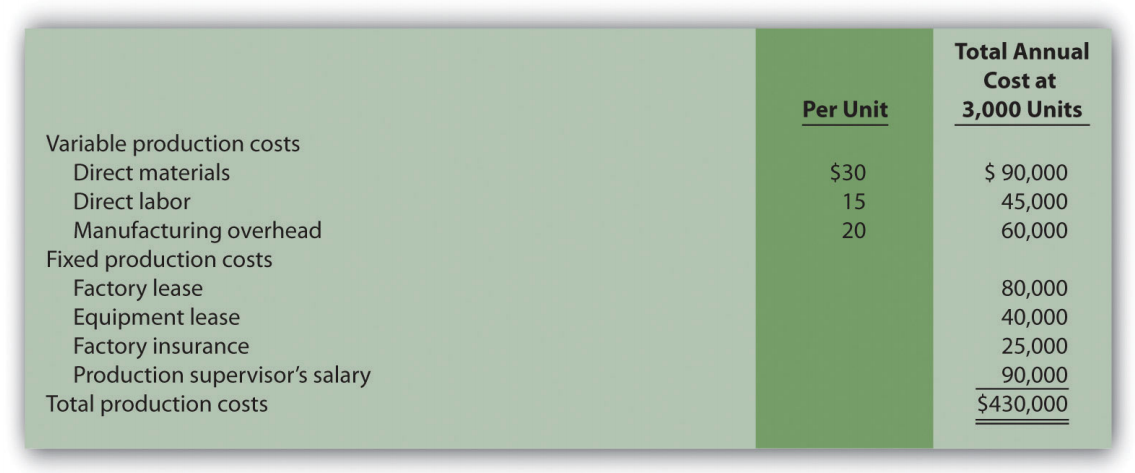
If production is outsourced, all variable production costs, equipment lease costs, and factory insurance costs will be eliminated. The production supervisor’s salary cost will remain regardless of the decision to outsource or to produce internally because the supervisor recently signed a long-term contract with the company. The factory lease has five years remaining and cannot be terminated before then.
Required:
- Perform differential analysis using the format presented in Figure 9.2. Assume making the product internally is Alternative 1, and buying the product from an outside manufacturer is Alternative 2.
- Which alternative is best? Explain.
- Summarize the result of outsourcing production using the format presented in Figure 9.3.
- Assume Vail Door Company can lease the space it currently uses to produce doors for $30,000 per year if production of doors is outsourced. Because the company subleasing this space would also pay for insurance, Vail would not be required to pay for factory insurance. Use the format presented in Figure 7.3 to determine if Vail would be better off outsourcing production. (Hint: $30,000 will appear in the analysis as an opportunity cost similar to Figure 9.8.)
- Make-or-Buy Decision and Qualitative Factors. Soda Bottling, Inc., currently bottles its own soda drinks. Management is interested in outsourcing the production of bottles to a reputable manufacturing company that can supply the bottles for $0.04 each. Soda Bottling incurs the following monthly production costs to produce 1,000,000 bottles internally.

If production is outsourced, all variable production costs and 70 percent of fixed production costs will be eliminated.
Required:
- Perform differential analysis using the format presented in Figure 9.2. Assume making the product internally is Alternative 1, and buying the product from an outside manufacturer is Alternative 2.
- Which alternative is best? Explain.
- Summarize the result of outsourcing production using the format presented in Figure 9.3.
- Assume all the facts of this problem remain the same. However, management of Soda Bottling has an opportunity to lease the space it currently uses to produce bottles for $6,000 per month if production of bottles is outsourced. Use the format presented in Figure 9.3 to determine if Soda Bottling would be better off outsourcing production. (Hint: $6,000 will appear in the analysis as an opportunity cost similar to Figure 9.8.)
- Identify at least one qualitative factor that should be considered before management decides to outsource production.
-
Product Line Decision. The following monthly segmented income statement is for Hal’s Hardware.
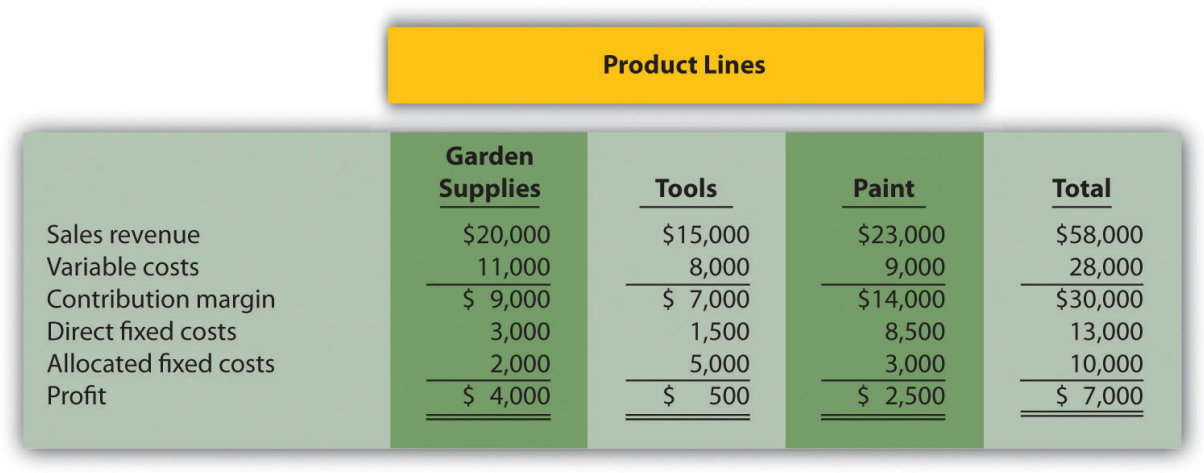
Management is concerned about the low profit associated with the tools product line and is considering dropping this product line. Allocated fixed costs are assigned to product lines based on floor space used by each product line (measured in square feet), resulting in the following percentages for garden supplies, tools, and paint, respectively: 20 percent, 50 percent, and 30 percent. If the tools product line is eliminated, total allocated fixed costs will be assigned as follows: 62.5 percent to garden supplies, and 37.5 percent to paint. All variable and direct fixed costs for the tools product line will be eliminated.
Required:
- Perform differential analysis using the format presented in Figure 9.6. Assume keeping all product lines is Alternative 1, and dropping the tools product line is Alternative 2.
- Which alternative is best? Explain.
- Summarize the result of dropping the tools product line using the format presented in Figure 9.7.
- Assume the space available from dropping the tools product line can be used by the paint product line, resulting in increased revenues for paint of $12,000 and increased variable costs for paint of $4,000. No additional direct fixed costs would be incurred, and 80 percent of allocated fixed costs would be assigned to paint and 20 percent assigned to garden supplies. Should Hal’s Hardware drop the tools product line and use the freed-up space to expand the paint product line? (Hint: Prepare a differential analysis using the format presented in Figure 9.6 to find the answer. Alternative 1 assumes all product lines are kept, and Alternative 2 assumes the tools product line is dropped with a corresponding expansion of the paint product line.)
-
Product Line Decision and Qualitative Factors. The following annual segmented income statement is for Wax, Inc., a maker of wax for cars, boats, and floors.
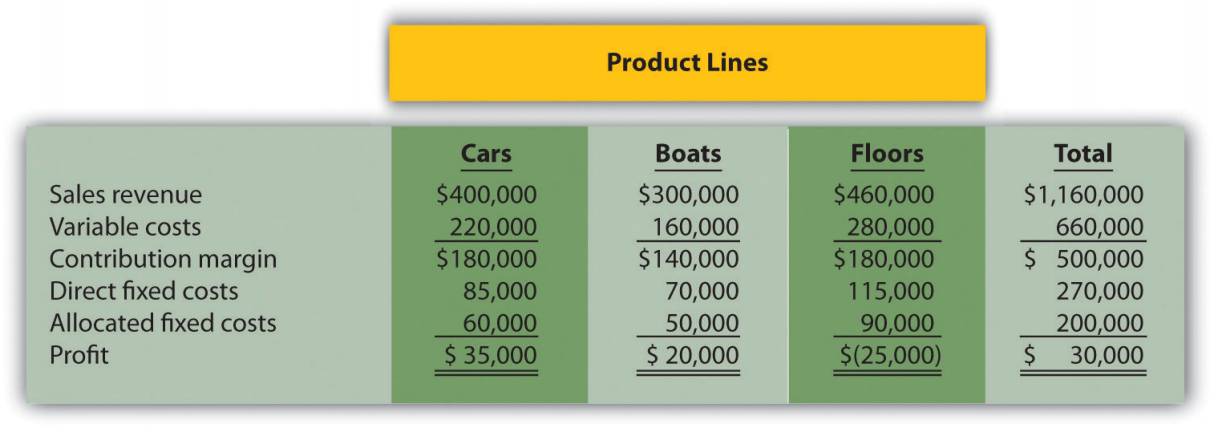
Management is concerned about the loss associated with the floors product line and is considering dropping this product line. Allocated fixed costs are assigned to product lines based on direct labor hours associated with each product line, resulting in the following percentages for cars, boats, and floors, respectively: 30 percent, 25 percent, and 45 percent. If the floors product line is eliminated, total allocated fixed costs will be assigned to the remaining products as follows: 55 percent to cars, and 45 percent to boats. All var able and direct fixed costs for the floors product line will be eliminated.
Required:
- Perform differential analysis using the format presented in Figure 9.6. Assume keeping all product lines is Alternative 1, and dropping the floors product line is Alternative 2.
- Which alternative is best? Explain.
- Summarize the result of dropping the floors product line using the format presented in Figure 9.7.
- Assume the space available from dropping the floors product line can be used by the boats product line, resulting in increased revenues for boats of $200,000 and increased variable costs for boats of $110,000. An additional $10,000 in direct fixed costs would be incurred for the boats product line.Allocated fixed costs would be assigned as follows: 40 percent to cars, and 60 percent to boats. Should Wax, Inc., drop the floors product line and use the freed-up space to expand the boats product line ? (Hint: Prepare a differential analysis using the format presented in Figure 9.6 to find the answer. Alternative 1 assumes all product lines are kept, and Alternative 2 assumes the floors product line is dropped with a corresponding expansion of the boats product line.)
- Identify at least one qualitative factor that should be considered before management decides to drop a product line.
- Customer Decision. The following customer segmented quarterly income statement is for Ciena and Associates, a firm that performs legal services.
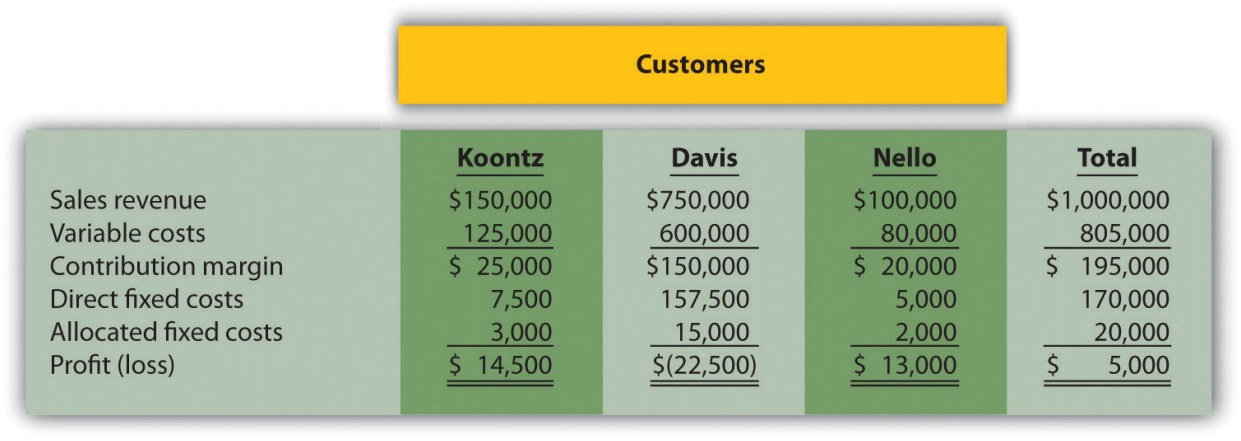
Management is concerned about the significant losses associated with the Davis account and would like to drop this customer. Allocated fixed costs are assigned to customers based on sales revenue. If Davis is dropped, total allocated fixed costs are assigned to the remaining customers, and all variable and direct fixed costs for the Davis account will be eliminated.
Required:
- Perform differential analysis using the format presented in Figure 9.10. Assume keeping all customers is Alternative 1, and dropping the Davis account is Alternative 2.
- Which alternative is best? Explain.
- Summarize the result of dropping the Davis account using the format presented in Figure 9.12.
- Explain what happened to the profitability of the other two customers as a result of dropping the Davis account.
- Assume all the facts of this problem remain the same with one exception. As a result of dropping the Davis account, Ciena and Associates is only able to reduce the direct fixed costs associated with the Davis account by 90 percent. The remaining 10 percent will not be eliminated for several more years. Does this change Ciena’s decision as to whether to drop the Davis customer? Explain. (Hint: Modify one line item in your answer to requirement c.)
- Customer Decision and Qualitative Factors. The following customer segmented monthly income statement is for Quality Web, Inc., a firm that provides Web site maintenance services.
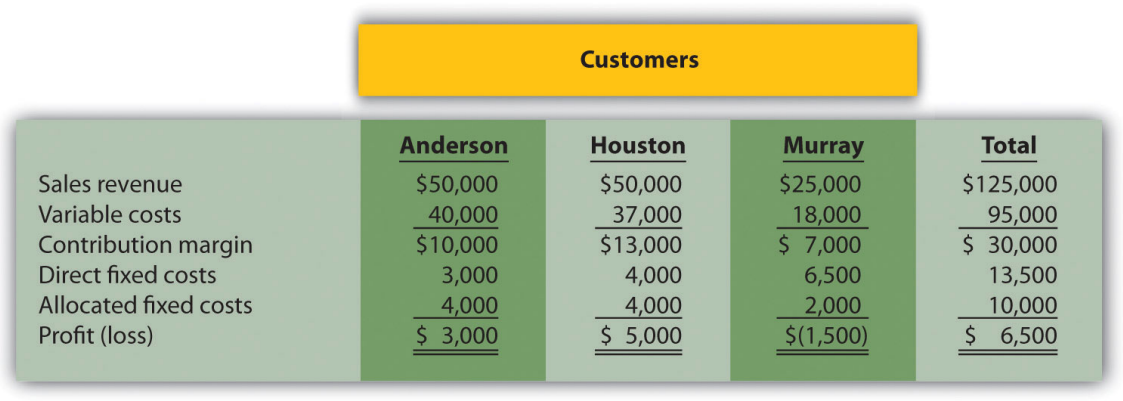
Management is concerned about the losses associated with the Murray account and would like to drop this customer. Allocated fixed costs are assigned to customers based on sales revenue. If Murray is dropped, total allocated fixed costs are assigned to the remaining customers, and all variable and direct fixed costs for the Murray account will be eliminated.
Required:
- Perform differential analysis using the format presented in Figure 7.10. Assume keeping all customers is Alternative 1, and dropping the Murray account is Alternative 2.
- Which alternative is best? Explain.
- Summarize the result of dropping the Murray account using the format presented in Figure 7.12.
- Explain what happened to the profitability of the other two customers as a result of dropping the Murray account.
- Assume all the facts of this problem remain the same with one exception. As a result of dropping the Murray account, Quality Web, Inc., is able to reduce total allocated fixed costs by 20 percent. The remaining 80 percent will be allocated to the other two products based on sales revenue. Does this change Quality Web’s decision as to whether to drop the Murray customer? Explain. (Hint: Add one line item in the requirement c analysis to reflect allocated fixed cost savings.)
- Identify at least one qualitative factor that should be considered before deciding whether to drop the Murray account.
-
Special Order Decision with Idle Capacity and at Full Capacity. The following quarterly financial data are for Pneumatic, Inc., a maker of compressors. On average, Pneumatic makes 20,000 compressors each quarter.

Pneumatic received an offer from a one-time customer to purchase 5,000 compressors this coming quarter for $275 per unit. Pneumatic can produce up to 30,000 units a quarter, so the special order would not affect regular customer sales. Variable costs per unit will remain at $100. This special order will have no effect on fixed costs.
Required:
- Using the differential analysis format presented in Figure 7.13, determine whether Pneumatic would be better off rejecting the special order (Alternative 1) or accepting the special order (Alternative 2).
- Summarize the result of accepting the special order using the format presented in Figure 7.14.
- Assume Pneumatic is approached with the same special offer, but has limited capacity, and can only produce up to 20,000 units per quarter. Thus any special orders will result in reduced sales to regular customers. Using the differential analysis format presented in Figure 7.13, determine whether Pneumatic would be better off rejecting (Alternative 1) or accepting (Alternative 2) the special order.
- Summarize the result of accepting the special order in requirement c using the format presented in Figure 7.14.
-
Special Order Decision at Full Capacity. The following monthly financial data are for Green Mowers, Inc., a maker of electric lawn mowers. On average, Green Mowers makes 5,000 mowers each month.

Green Mowers received an offer from a one-time customer to purchase 1,000 mowers this coming month for $180 per unit. Green Mowers can produce up to 5,000 units a month, so the special order would reduce regular customer sales. Variable costs per unit will remain at $150. This special order will have no effect on fixed costs.
Required:
- Using the differential analysis format presented in Figure 7.13, determine whether Green Mowers would be better off rejecting the special order (Alternative 1) or accepting the special order (Alternative 2).
- Summarize the result of accepting the special order using the format presented in Figure 7.14.
- Assume Green Mowers can increase capacity to accommodate the special order by paying an additional $20 in variable costs per unit (for overtime pay) for the additional 1,000 units. With this increased capacity, the special order would not affect regular customer sales. Using the differential analysis format presented in Figure 7.13, determine whether Green Mowers would be better off rejecting (Alternative 1) or accepting (Alternative 2) the special order.
- Summarize the result of accepting the special order in requirement c using the format presented in Figure 7.14.
-
Target Costing. Toolmakers, Inc., produces table saws. The marketing department has identified a market for a specific type of table saw that Toolmakers does not currently produce, and expects to be able to sell each saw for $800. Management requires a profit of 60 percent of the selling price.
Required:
- Determine the highest cost (target cost) management would be willing to accept to produce this product.
- Describe the four steps of target costing, and identify what Toolmakers would do next if it cannot make the product at or below the target cost.
- Constrained Resources. Instrumental Strings, Inc., produces three types of string instruments: violin, cello, and bass. The instruments are produced in separate departments and sent to the quality testing department before being packaged and shipped. A labor-hour bottleneck has been identified in the quality testing department due to the high skill requirements of the job. Instrumental Strings would like to optimize its use of labor hours by producing the two most profitable instruments. Information for each product follows.

Required:
- Calculate the contribution margin per unit of constrained resource for each product.
- Which two products would Instrumental Strings prefer to produce and sell to optimize the use of labor hours in the quality testing department?
- Assume additional employees are hired and trained for the quality testing department thereby alleviating this constraint. A labor-hour bottleneck has now been identified in the packaging department, which is recognized by management as a crucial department given the fine craftsmanship of each instrument. Of the three instruments produced by the company, identify which two products Instrumental Strings would prefer to produce and sell to optimize the use of labor hours in the packaging department. Assume the following labor hours are required to package each instrument:
| Violin: | 4.00 hours |
| Cello: | 4.00 hours |
| Bass: | 6.00 hours |
One Step Further: Skill-Building Cases
- Outsourcing Building Materials. Review Note 7.8 “Business in Action 7.1” What qualitative factors did the manager of the library’s construction likely consider in deciding to have Pretecsa produce the concrete panels?
- Internet Project: Outsourcing. Accenture LLP is a global management consulting, technology services, and outsourcing company with more than $17 billion in annual revenues. Go to Accenture’s Web site (www.accenture.com) and select outsourcing, or type outsourcing in Accenture’s search feature. Review the information provided about outsourcing, select a specific outsourcing topic, and write a one-page report summarizing your findings.
- Sale of Stores at Kmart. Refer to Note 7.17 “Business in Action 7.2” What qualitative factors were likely considered by the company’s management in considering whether to keep the stores?
- Group Activity: Qualitative Factors. Each of the following scenarios is being considered at three separate companies.
- A company sells three types of bicycles (racers, cruisers, and climbers), all of which are profitable. The company faces a labor-hour bottleneck and plans to eliminate the cruiser product because it has the lowest contribution margin per labor hour.
- A company plans to accept a special order at a reduced price from a one-time customer.
- A maker of car batteries plans to eliminate one of its unprofitable product lines.
Required:
Form groups of two to four students and assign one of the three independent scenarios listed previously to each group. Each group must perform the following requirements:
- Identify at least two qualitative factors that should be considered before making the decision.
- Discuss each option, based on the findings of your group, with the class.
-
Special Order Decision Using Excel. The following monthly financial data are for Green Mowers, Inc., a maker of electric lawn mowers. Green Mowers makes and sells 5,000 mowers each month.

Green Mowers received an offer from a one-time customer to purchase 1,000 mowers this coming month for $180 per unit. Green Mowers can only produce up to 5,000 units a month, so the special order would reduce regular customer sales. Variable costs per unit will remain at $150. This special order will have no effect on fixed costs.
Required:
Prepare an Excel spreadsheet, similar to the one shown in the Computer Application box, to determine whether Green Mowers would be better off rejecting the special order (Alternative 1) or accepting the special order (Alternative 2). Make a recommendation as to which alternative should be accepted and explain the reasoning for your recommendation.
- Ethics: Cost-Plus Pricing. JR Engineering recently negotiated a cost-plus contract with Pineville City to provide engineering services at a rate equal to direct labor costs plus 30 percent. On a separate note, the partners at JR Engineering discovered that one of its customers filed for bankruptcy last month and will not be able to pay the $200,000 owed to the firm.The two partners at JR Engineering, Julie and Ron, decided to include some of the direct labor costs incurred working on the bankrupt company with the direct labor costs associated with Pineville City. As Ron stated, “After all, customers fail from time to time, and it’s only fair that our other customers shoulder some of the burden. This enables us to provide the high-quality service we know is so important to our customers.” Are JR Engineering’s actions ethical? What are the long-term implications of JR’s actions? Explain.
Comprehensive Cases
- Make-or-Buy Decision. Keyboard, Inc., a manufacturer of pianos, typically sells each of its pianos for $1,480. The cost of manufacturing and marketing one piano at the company’s usual monthly volume of 6,000 units is shown.
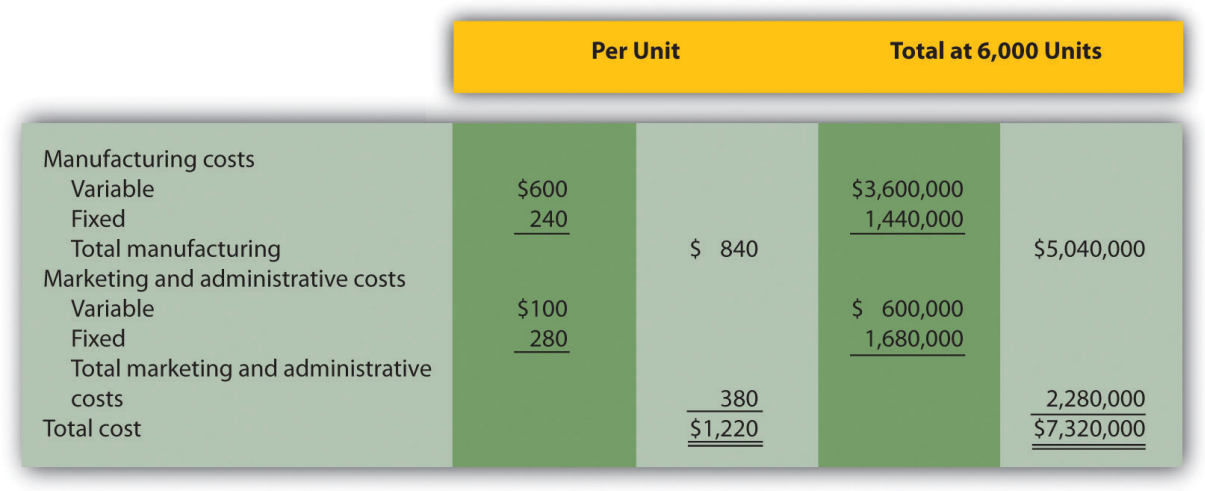
Required:
- Keyboard, Inc., received a proposal from an independent piano manufacturer that will produce and ship 2,000 pianos each month directly to Keyboard’s customers as requested by Keyboard’s salespeople, at a cost of $900 each. This will have the effect of reducing total fixed marketing and administrative costs by 5 percent. As a result of reducing production capacity, Keyboard’s total fixed manufacturing costs will decrease 30 percent. Total variable manufacturing costs will decrease since only 4,000 pianos will be produced rather than 6,000. Total variable marketing and administrative costs will remain unchanged.Perform differential analysis using the format presented in Figure 9.2 to determine if Keyboard should accept the proposal from the outside supplier. Assume making all 6,000 pianos internally is Alternative 1, and outsourcing the production of 2,000 pianos and producing 4,000 pianos internally is Alternative 2. Explain which alternative is best.
- Assume the same facts as in requirement a, with one additional point. If production of 2,000 pianos is outsourced and 4,000 pianos are produced internally, Keyboard can use the idle capacity to produce an additional 1,400 beginner pianos that can be sold for $1,100 each. Fixed marketing and administrative costs would be unchanged (the 5 percent reduction described in requirement a no longer applies). Fixed manufacturing costs would decrease by 10 percent (rather than the 30 percent described in requirement a). Per unit variable cost information for the beginner pianos would be as follows:
| Variable manufacturing costs | $400 |
| Variable marketing and administrative costs | $80 |
Perform differential analysis using the format presented in Figure 7.2 to determine if Keyboard should accept the proposal from the independent supplier. Assume making all 6,000 pianos internally is Alternative 1. Alternative 2 consists of outsourcing the production of 2,000 pianos and producing 5,400 pianos internally (= 4,000 regular pianos + 1,400 beginner pianos). Explain which alternative is best. (Hint: Include a line item for sales revenue in your analysis to determine the best alternative.)
-
Product Line Decision. The following monthly segmented income statement is for Thirst Quench, a maker of soda, sports drink, and lemonade.
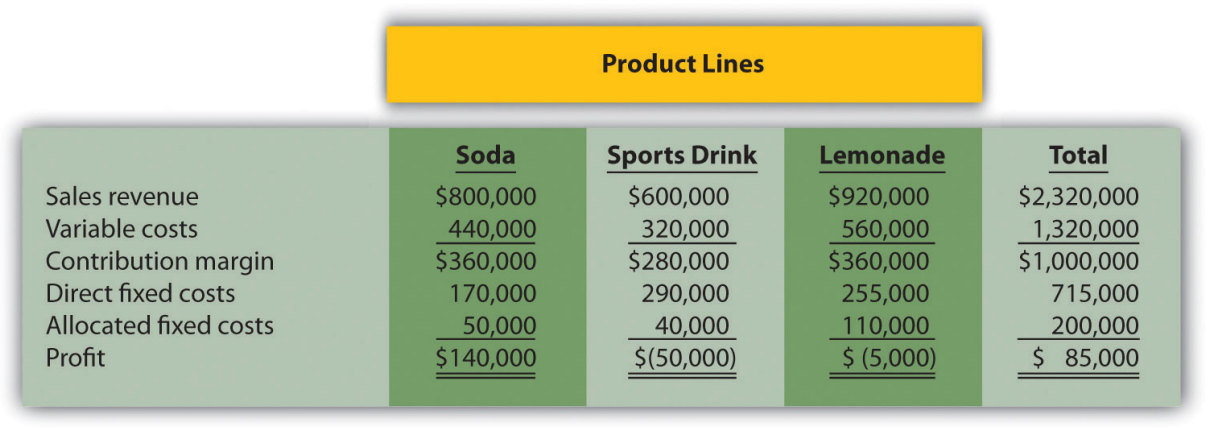
Management is concerned about the losses associated with the sports drink and lemonade product lines and is considering dropping all product lines except soda. Allocated fixed costs are assigned to product lines based on direct labor hours associated with each product line resulting in the following percentages for soda, sports drink, and lemonade, respectively: 25 percent, 20 percent, and 55 percent. If the sports drink and lemonade product lines are eliminated, total allocated fixed costs will decrease by $40,000, and variable costs and direct fixed costs for these two product lines will be eliminated. (No allocated fixed cost savings occur if only one product line is dropped.)
Required:
- Perform differential analysis using the format presented in Figure 7.6. Assume keeping all product lines is Alternative 1, and keeping only the soda product line is Alternative 2.
- Which alternative is best? Explain.
- Summarize the result of keeping only the soda product line using the format presented in Figure 7.7.
- Management has asked you to look at the numbers for each product line and make a recommendation on how to increase overall company profit. What course of action would you recommend? Based on your recommendation, describe the qualitative factors that should be considered.


